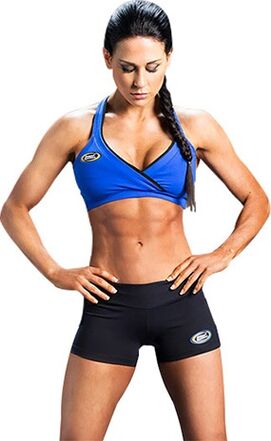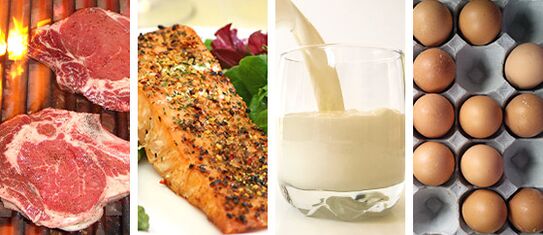
We invite you to learn more about the low-carb ketogenic diet and its three variations: the standard, cyclic, and targeted ketogenic diet. This guide includes detailed instructions for creating a nutrition plan and formulas for calculating nutrient requirements.
The history of the ketogenic diet goes back several decades, and during that time it has managed to gather many ardent followers in the bodybuilding subculture. In general, the ketogenic diet and its variants are diets rich in fat and protein, but extremely low in carbohydrates (less than 10% of total macronutrients); With such a diet, the body is forced to use fat as fuel, because glucose reserves are quickly depleted.
For many, the ketogenic diet can be an effective and very effective way to achieve their goals, whether it's building muscle mass, burning fat, building strength, and more. Although the ketogenic diet is mainly used for fitness and health purposes, it is also used in complex treatment algorithms for epilepsy.
You might ask, "How is the ketogenic diet different from other low-carb diets? " Honestly, there isn't that much difference. Many believe that such a nutritional system is most effective when the body enters a state called "ketosis" and begins to synthesize ketones for further energy production (hence the "ketogenic" diet), and such a transition is possible only then. severe restriction of carbohydrate intake. However, looking at the problem in this way is short-sighted, and we will definitely touch on this later.

In this guide, we'll take a closer look at the physiological processes underlying the ketogenic diet, look at the types/variations of ketogenic diets available, learn how to create your own, and provide some simple tips for weight loss. your appetite for low-carb foods. And, of course, we will answer the most common questions.
What is ketosis?
As mentioned earlier, the ketogenic diet got its name because the restriction of carbohydrate consumption inherent in this food system can bring the body into a state of ketosis - a special physiological state in which the concentration of ketone bodies increases.
Ketone bodies are water-soluble organic biomolecules that are synthesized from fatty acids in the liver when food intake (especially carbohydrates) is reduced. These biomolecules can be used as an energy source after being transported to extrahepatic tissues.
Ketone bodies are constantly synthesized in small amounts in the human body, but normally the concentration of ketones is so low that they are not detected in a urine test. However, when the level of ketone bodies in the blood increases (a condition known as ketonemia), they begin to be excreted in the urine (known as ketonuria); ketonemia and ketonuria taken together indicate that the body is in a state of ketosis.
Therefore, the goal of the ketogenic diet is to put the body in a state of nutritional ketosis (not to be confused with pathological ketosis), which directs the metabolism to use fatty acids and ketone bodies as the main energy source.
Basic Ketogenic Diet Options
In this guide, we'll explore the three main ketogenic diet options: the standard ketogenic diet (SKD), the cyclic ketogenic diet (CKD), and the targeted ketogenic diet (TCD). The type of diet you need is determined solely by trial and error and is largely determined by your priority goals (more on that below).
- The standard ketogenic diet– This is the simplest, most basic version of the ketogenic diet. SCD does not include periods of carbohydrate replenishment as required by CCD and TKD. It is a linear diet characterized by a steady supply of ketogenic nutrients (moderate to high protein intake, high fat intake, and extremely low carbohydrate intake).
- The cyclic ketogenic dietis a variant of the nutritional system that involves short-term carbohydrates to replenish muscle glycogen stores after the body's reserves are completely depleted. The length of time between carbohydrate loads will vary depending on individual preferences, exercise intensity and goals.
- Targeted Ketogenic Diet- This is the last version of the energy system that interests us. TKD provides a short-term carbohydrate supply during the training window. The goal of TKD is to refuel the body with glucose to improve physical performance without stifling ketosis in the long term.

Which option should I take?
Many factors will influence the choice of diet type. It is recommended to start "short term" using a standard ketogenic diet. After a few weeks of such a break, you will be able to assess how your body reacts to changes in diet, how your physical performance has changed, and how much energy you have. This will make it easier for you to decide which diet to use in the long run.
You may also have doubts about which option is better for losing weight and which is ideal for gaining muscle mass. That said, if the total energy value of your diet meets your goals, choosing a ketogenic diet won't become a major factor in reaching your goal. You may find that CD or TCD is better for those who want to gain muscle mass, because carbohydrates save protein and stimulate insulin secretion, and standard CD will be an ideal choice for those who want to lose weight, because insulin synthesis should be relatively low. However, in the long run, these short-term fluctuations in insulin secretion will not be as critical a factor as the total caloric intake of the diet.
Below is a brief overview of factors to consider when choosing a ketogenic diet option:
- SKD. It is ideal for people who lead a mainly sedentary lifestyle and whose physical performance does not deteriorate when severely restricting carbohydrate intake. SKD will also be an excellent choice for people who do not exercise very intensely and who have high insulin resistance.
- TKD. If you train your core a few times a week and find that your performance suffers with long-term carb restriction, it may be worth considering carb loading for a short period of time before and possibly after your workout. In addition, TKD would be a good choice for people with more training experience who may benefit from a small carb boost but not a heavy carb load.
- TsKD. Cyclic KD is often referred to as "the cutting edge" of all ketogenic diet options. CCD requires a person to patiently go through a phase of trial and error, during which the optimal time between carbohydrate loadings is sought and the amount of carbohydrates needed on loading days is determined. If you consider yourself an experienced athlete, if you train actively all week and even notice a decrease in performance against the background of SCD or TKD, consider CCD. Perhaps this option will help you get back to work as quickly as possible.
Create your own ketogenic diet
In this section we will talk about how to determine the energy and macronutrient needs of the body; these numbers will be your main guidelines when creating the SCD diet. People choosing CCD or TCD will also need to use the basic calculations for CCD, but with minor adjustments that I'll talk about later.
In general, anyone who wants to lose weight should stick to the golden rule of a 500-calorie deficit per day, and anyone who wants to gain muscle mass should achieve the same 500-calorie surplus. But this is a very rough generalization without taking into account physiological characteristics and other factors. Additionally, if you choose CDD, you will likely need to adjust your calorie intake for a week.
An example of how to calculate your macronutrient intake for ADS:
- Determine your energy needs using a daily calorie calculator;
- Daily protein requirement 2 g/kg dry weight: 150 g per day
- Carbohydrate requirement 0. 2-0. 4 g/kg dry weight: 15-30 g per day (in the following calculations we start with 30 g)
- Since there are 4 calories in 1 g of protein and carbohydrates, we get (150 + 30) x 4: 720 calories from protein and carbohydrates.
- We get that this person should get 1280 calories (2000 - 720) from fat, and since there are 9 calories in a gram of fat, he should eat about 142 (divide by 1280 to 9) grams of fat per day.
So, in total, this person's daily diet would include 150 grams of protein, 30 grams of carbohydrates, and 142 grams of fat. Let's divide this amount between meals.
Example of 3 meal plans:
| squirrels | Carbohydrates | Oils | |
|---|---|---|---|
| 1st meal | 50 g | 10 gr | 48 g |
| 2nd meal | 50 g | 10 gr | 47 g |
| 3rd meal | 50 g | 10 gr | 47 g |
Example of a 5 meal meal plan:
| squirrels | Carbohydrates | Oils | |
|---|---|---|---|
| 1st meal | 30 gr | 5 g | 29 g |
| 2nd meal | 30 gr | 5 g | 29 g |
| 3rd meal | 30 gr | 5 g | 28 g |
| 4th meal | 30 gr | 5 g | 28 g |
| 5th meal | 30 gr | 5 g | 28 g |
Choosing Foods for the Ketogenic Diet
There are no strict rules on the ketogenic diet, such as no allowed or prohibited foods. Many believe that the main sources of starch and sugar should not be included in the diet at all, because this will prevent the metabolism from going into a state of ketosis, but small amounts of such products are unlikely to cause an obstacle, especially for nutrition. great people.

Good choices for the ketogenic diet include:
- Animal protein (especially red meat)
- Eggs (whole or white only)
- Fatty dairy products are cheese, cream, butter, etc.
- Fats, preferably vegetable oils, peanuts, flaxseeds, macadamia nuts, olives, and some types of coconut
- Nuts and nut butters
- Fibrous vegetables, especially green vegetables, lettuce, broccoli, celery, etc.
Don't limit yourself during the loading phase of the ketogenic diet and include more sources of starch and sugar in your diet, such as fruits.
Central Control Center planning
Now let's look at how you should incorporate carbohydrates into the cycling version of the ketogenic diet.
Those who choose CC should start by carb loading once a week and then adjust the time interval between loading days according to their individual needs. Be prepared to do a lot of experiments that will evaluate how many carbohydrates you eat on the loading day and how you feel in the following days.
The main thing to remember when carb loading is to reduce your fat intake; Do not continue to eat large portions of fat on loading days. But leave your protein intake the same (or even increase it to maintain your total calories).
Using the macronutrient needs of a 75 kg person mentioned earlier, here are some basic recommendations for building a daily loading RDA based on individual insulin sensitivity/carbohydrate tolerance:
- Protein requirement 2 g/kg dry weight: 150 g/day
- For low insulin sensitivity, we calculate carbohydrate intake on the basis of 2-3 g per kg of dry weight
- With normal insulin sensitivity, we calculate carbohydrate intake based on the calculation of 4-5 g per kg of dry weight.
- For high insulin sensitivity, we calculate carbohydrate intake based on a calculation of 6-7 g per kg of dry weight.
- Now, as before, we simply count the remaining calories, divide by 9, and get the grams of fat that should be taken on carbohydrate loading days.
An example CDF for a person with normal insulin sensitivity and 75 kg of lean body mass eating a 2000 calorie restriction diet is:
- Monday - Saturday: food intake should be in accordance with the pre-calculated requirements for SKD
- Sunday (carb loading day, 2500 calories) – 150g protein/300g carbs/78g fat
TCD planning
Now let's see how to integrate carbohydrates into a targeted version of the ketogenic diet (pre- and post-workout in our example).
As with CCD, when starting TCD, first assess how your body reacts to a certain amount of carbohydrates and determine for yourself the optimal time to take them. Remember that when following the TKD, you need to consume enough carbohydrates for optimal performance, but not overdo it. CDD implies the existence of periods of replenishment of glycogen stores, while TCD only targets short-term increases in energy and performance.
Therefore, if an athlete is training intensively 5 days a week, he should consume carbohydrates before and/or after training on those training days. On the remaining days, food intake should be consistent with the calculations for SCD.
The calculation of nutritional needs during TKD is actually no different from SKD; we simply add carbs to the "non-workout" meal on training days. To illustrate how to plan carbohydrate training during TKD, here are recommendations for the same 75 kg athlete who is in a cutting phase, consuming 2000 calories per day, and has some insulin sensitivity/carbohydrate tolerance:
- Protein requirement 2 g/kg dry weight: 150 g/day
- If insulin sensitivity is low, add 0. 5 g of carbohydrates per 1 kg of dry weight to the "near-exercise" meal.
- For normal insulin sensitivity, add 0. 75 g of carbohydrates per 1 kg of dry weight to the "close training" meal.
- If you have high insulin sensitivity, add 1g of carbohydrate per 1kg of dry weight to your "during exercise" meal.
- Now we subtract the "extra" calories from carbohydrates and proteins from the daily energy requirement and add the missing calories from fats (everything is the same as before).
A "pre-workout" meal comes before or after a workout. This means that you can randomly distribute the "extra" carbs, only they are all eaten in the training window. In general, it is recommended to simply divide the total amount in half and eat before and after training.
An example of a five-meal TCD diet (exercise day) for an individual with 75 kg of lean mass and high insulin sensitivity on a diet of 3000 calories per mass:
| squirrels | Carbohydrates | Oils | |
|---|---|---|---|
| 1st meal (before training) | 30 gr | 40 g | 20 g |
| 2nd meal (post workout) | 30 gr | 35 g | 20 g |
| 3rd meal | 30 gr | 10 gr | 30 gr |
| 4th meal | 30 gr | 10 gr | 30 gr |
| 5th meal | 30 gr | 10 gr | 30 gr |
Thin tincture of TsKD and TKD
Remember that the above recommendations for carbohydrate intake on cyclic and targeted ketogenic diets are only a starting point. It is impossible to develop a comprehensive and optimal diet that will meet the needs of everyone reading this article because there are so many factors to consider.
For this reason, as mentioned earlier, you need to be careful, thorough and open to experimentation when adopting advanced versions of ketogenic diets such as TKD and CCD. As you go, you will learn what is best for your body. Always listen to your body and be prepared to make the adjustments it requires.
If you eat 30g of carbs a day and feel great in the gym, follow this strategy; If you feel more comfortable with carb loading two days a week, do it. The carbohydrate needs recommended in this guide are based on experience rather than rigorous scientific research, and you may feel free to adjust them to suit your individual needs.

And the last tip is especially related to TKD. You should reduce the amount of fat in foods that contain a lot of carbohydrates. This doesn't mean you shouldn't get fat at all in your pre-workout meal, you just need to eat a balanced diet and distribute the lion's share of fat between the rest of your meals.
An insight into the role of saturated fat in the ketogenic diet
Starting a ketogenic diet will inevitably increase the proportion of saturated fat in your diet, but that doesn't mean you have to rely entirely on saturated fat and ignore your polyunsaturated fat intake.
There is considerable debate about how much saturated fat is considered excessive on a ketogenic diet. Many people who try the ketogenic diet avoid fat, fatty red meat, full-fat dairy, etc. insists on large portions of foods such as
Saturated fats are related to the production of sex hormones (androgens) in the male body, and therefore a sharp reduction in their consumption can hardly be called a good idea. However, chronic excess consumption of saturated fat can lead to increased insulin resistance and other metabolic disorders, so loading the body with these foods is not our plan.
In my opinion, on the background of a ketogenic diet, you can safely increase the proportion of saturated fats in the diet to 20-30% of total fat. That is, if a person gets 150 grams of fat from daily food, he should try to limit the amount of saturated fat to 30-45 grams per day.
Frequently asked questions
Question:Is it possible to include the main sources of carbohydrates in the ketogenic diet menu?
Answer:Some proponents of the ketogenic diet strongly argue that basic carbohydrate foods should be completely excluded. However, in the case of larger people who can eat more carbohydrates and still remain in ketosis, it is possible to make dietary "mistakes" in the form of grains, cereals, fruits and starchy vegetables.
Question:Can you eat more protein and less fat on a ketogenic diet?
Answer:Yes, but remember that consuming too much protein will simply increase gluconeogenesis in the liver, which in turn will once again make glucose the primary fuel source.
Question:Should I use ketone test strips to make sure my body is in ketosis? Should I be worried that I have not reached this state?
Answer:You should not pay too much attention to the presence of ketone bodies in the urine and the formal state of "ketosis". As long as you consume very few carbohydrates in your diet, you will use fats and ketones for the lion's share of your body's energy needs.
Question:Can I use artificial sweeteners and sugar substitutes while on a ketogenic diet?
Answer:In most cases, yes. But keep in mind that some sugar substitutes contain small amounts of fillers, such as maltodextrin and dextrose, and if you overindulge in sweeteners, the amount of these fillers in your diet can rise to alarming levels.
Question:Is the ketogenic diet safe for people with high cholesterol?
Answer:It's generally safe, especially if most of the fat comes from unsaturated sources. However, if you have chronic diseases, it is advisable to ask this question to your doctor and only after his blessing, switch to a ketogenic diet.
Question:Should plant fiber be included in the total caloric intake of the diet?
Answer:Plant fibers are not listed as "net carbohydrates" on food labels. However, vegetable fiber, like any food, contains calories.
Question:After high carb meals (carb loading) I feel bloated and sleepy. What do I have to do?
Answer:You can try to increase the frequency of meals and distribute carbohydrate foods more evenly. Or try to eat the lion's share of carbohydrates in the evening, after a meal you can finally relax and tune in to passive relaxation.
Question:When I first tried the ketogenic diet, I felt out of place. This is a good?
Answer:Many people feel exhausted within a few weeks, especially if their diet was previously based on high-carbohydrate foods. However, if your performance does not recover over time, try TCD or CDT and see if that helps.
The result
I hope this in-depth look at the ketogenic diet has taught you a lot and given you some useful information to help you take your first steps. Remember, you should be open to experiences and listen carefully to the signals your body is sending.
Many people use low-carb, high-fat diets with great success, while others feel terrible on a ketogenic diet and can't function or function normally. If you understand that you belong to the second group, do not try to force your body for the diet itself and stick to the ketogenic diet.
Ultimately, your diet should do two things - help you achieve your fitness and health goals without interfering with your daily life. You don't have to sacrifice one for the other, although many people do when setting new goals. It doesn't matter how good a diet looks on paper or in theory if you can't stick to your plan. Do what's best for you and stay the course for the long haul. Here is the secret of success.
















